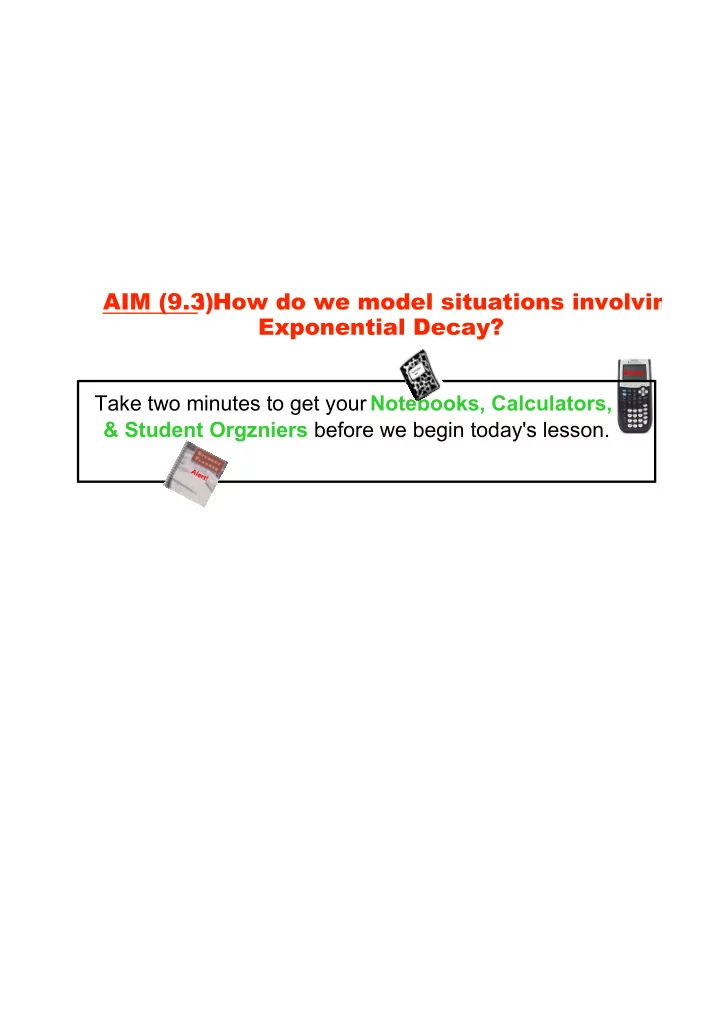

AIM (9.3) : How do we model situations involving Exponential Decay? Alert! Take two minutes to get your Notebooks, Calculators, & Student Orgzniers before we begin today's lesson. A l e r t !
Aim 9.3: How do we model situations involving Exponential Decay? HW: Complete worksheet 9.3 DoNow Begins! Regina is such a gossip! She decided to start a rumor about a junior boy and told three of her friends the story she made up. The next day those three girls each told another three people about the rumor. And the next day each of those people each told another three people. This pattern went on day after day! On the day ten, how many people will hear the rumor Regina started? Hint: Determine whether or not this is a linear or exponential situation and write a rule. Create a table or draw a diagram to model the situation if you need a visual element.
Aim 9.3: How do we model situations involving Exponential Decay? HW: Complete worksheet 9.3 Regina is such a gossip! She decided to start a rumor about a junior boy and told three of her friends the story she made up. The next day those three girls each told another three people about the rumor. And the next day each of those people each told another three people. This pattern went on day after day! On day ten, how many people will hear the rumor Regina started? 59,049 People
Aim 9.3: How do we model situations involving Exponential Decay? HW: Complete worksheet 9.3 HOMEWORK QUESTIONS? 1) $9,421.83 and $16,968.18 2) $232,810.20 3) $53.76 4) $4,241.01 5) $1,264.30 6) 270 frogs 7) 189 and 13,382,588 and 7.687 x 10 43
Aim 9.3: How do we model situations involving Exponential Decay? HW: Complete worksheet 9.3 HOMEWORK REVIEW
Aim 9.3: How do we model situations involving Exponential Decay? HW: Complete worksheet 9.3 HOMEWORK REVIEW
Aim 9.3: How do we model situations involving Exponential Decay? HW: Complete worksheet 9.3 MIDTERM next Wednesday (Units 6, 7, 8, and Lessons 9.1 9.4) 30 Questions: 24 MC, 6 Long Answer Partial Credit for Long Response only You may prepare one letter sized cheat sheet (double sided) to use on the Midterm. 3 most creative cheat sheets will win +10 points on Midterm.
Aim 9.3: How do we model situations involving Exponential Decay? HW: Complete worksheet 9.3 Real World Examples of Exponential Functions/Decay
Aim 9.3: How do we model situations involving Exponential Decay? HW: Complete worksheet 9.3 Since 1980, the number of gallons of whole milk each person in the United States drinks each year has decreased 4.1% each year. In 1980, each person drank an average of 16.5 gallons of whole milk per year. What was the approximate consumption per person of whole milk in 2000? starting amount exponent, usually # years y = a b x amount after time The base , or decay factor , is between 0 and 1
Aim 9.3: How do we model situations involving Exponential Decay? HW: Complete worksheet 9.3 As a With On Partner? PostIt? Class? Exponential Decay ~ Depreciation A new car is worth $20,000. It depreciates in value (decreases in value) at a rate of 15% per year. What will the car be worth in five years?
Aim 9.3: How do we model situations involving Exponential Decay? HW: Complete worksheet 9.3 A new car is worth $20,000. It depreciates in value (decreases in value) at a rate of 15% per year. What will the car be worth in five years?
Aim 9.3: How do we model situations involving Exponential Decay? HW: Complete worksheet 9.3 How do we find the base for an exponential decay function that involves percentage?
Aim 9.3: How do we model situations involving Exponential Decay? HW: Complete worksheet 9.3 Classwork Time! 1) A powerful computer is purchased for $2000, but on the average loses 20% of its value each year. How much will it be worth 4 years from now? 2) A house purchased in a notsogreat neighborhood for $226,000 has lost 4% of its value each year for the past five years. What is it worth now? • Complete Classwork independently • Check your answers with a partner. • If you get stuck, signal red .
Aim 9.3: How do we model situations involving Exponential Decay? HW: Complete worksheet 9.3 1) A powerful computer is purchased for $2000, but on the average loses 20% of its value each year. How much will it be worth 4 years from now? 2) A house purchased in a notsogreat neighborhood for $226,000 has lost 4% of its value each year for the past five years. What is it worth now?
Aim 9.3: How do we model situations involving Exponential Decay? HW: Complete worksheet 9.3 Exit Ticket On PostIt The number of carbon atoms in a fossil is given by x , where x represents the function y = 5100(0.95) the number of years since being discovered. 1) How many carbon atoms are left after 3 years? (round to the nearest tenth) 2) What is the percent of change each year? Explain how you arrived at your answer.
Aim 9.3: How do we model situations involving Exponential Decay? HW: Complete worksheet 9.3 Exit Ticket The number of carbon atoms in a fossil is given by x , where x represents the function y = 5100(0.95) the number of years since being discovered. 1) How many carbon atoms are left after 3 years? (round to the nearest tenth) 2) What is the percent of change each year? Explain how you arrived at your answer.
Get a head start on your homework! 207A Tuesdays & Fridays
Recommend
More recommend